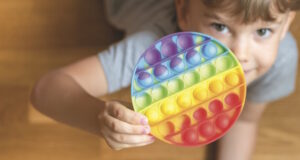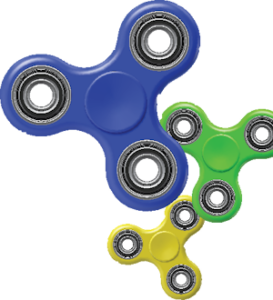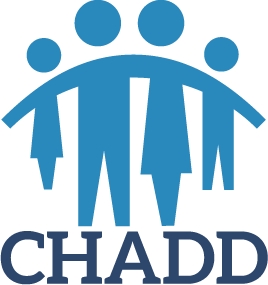How Does Fidgeting Enhance Focus for Individuals with ADHD?
Roland Rotz, PhD
Attention Magazine February 2025
Download PDF
Eight-year-old Joey gets in trouble daily at school for restless behavior that involves fidgety movements with hands and feet. His father sits in the office boardroom during an hour-long meeting where he rocks in his chair and doodles while taking notes. Both have been diagnosed with ADHD. These behaviors are presumed to disrupt their concentration and distract those around them.
 Characterized by symptoms such as inattention, hyperactivity, and impulsivity, ADHD is a neurodevelopmental condition affecting individuals like Joey and his father who often face challenges in maintaining focus during tedious tasks, especially in situations that require prolonged attention. Interestingly, many people with ADHD naturally engage in fidgeting behaviors—small, mindless movements such as tapping a pencil, bouncing a leg, or playing with a stress ball. Understanding the conditions under which fidgeting can negatively or positively impact concentration and focus is essential for individuals, educators, therapists, and caregivers.
Characterized by symptoms such as inattention, hyperactivity, and impulsivity, ADHD is a neurodevelopmental condition affecting individuals like Joey and his father who often face challenges in maintaining focus during tedious tasks, especially in situations that require prolonged attention. Interestingly, many people with ADHD naturally engage in fidgeting behaviors—small, mindless movements such as tapping a pencil, bouncing a leg, or playing with a stress ball. Understanding the conditions under which fidgeting can negatively or positively impact concentration and focus is essential for individuals, educators, therapists, and caregivers.
Fidgeting disrupts focus
Fidgeting can sometimes lead to disruptions in concentration, particularly when it becomes excessive or distracting. Here are several ways fidgeting may disrupt focus.
● Increased distraction. Excessive fidgeting can divert attention away from the task at hand. When individuals engage in fidgeting behaviors that are too noticeable—like tapping, bouncing, or creating noise—they may not only lose focus but also distract their peers. This can lead to a reduction in productivity in group settings such as classrooms or workplaces (Parker, 2020).
● Difficulty engaging in complex tasks. Fidgeting can be particularly disruptive during tasks that demand deep concentration and cognitive effort. When cognitive resources are divided between focusing on the task and managing fidgeting behaviors, individuals may struggle to process information effectively. Research shows that tasks requiring sustained attention can be negatively impacted by competing actions, leading to poorer performance overall (Baird, 2018).
● Social disruptions. Fidgeting behaviors may also elicit negative reactions from peers, teachers, or supervisors, which can create an uncomfortable social atmosphere. If fidgeting is perceived as disruptive or annoying, it can lead to social rejection or isolation, further affecting the individual’s ability to focus (Kern, 2019). Social stress can take cognitive resources away from the task, making it harder to concentrate.
● Overstimulation. For some individuals, especially those with sensory sensitivities, fidgeting can lead to overstimulation. Engaging in fidgeting behaviors can create a sensory overload that makes it hard to concentrate, as the brain processes multiple competing stimuli (Harris, 2018). This can lead to frustration and an inability to focus on tasks requiring sustained attention.
● Competing cognitive load. Fidgeting often requires cognitive resources, especially when individuals attempt to manage their fidgeting while also concentrating on a task. This can lead to an increase in cognitive load, which can overwhelm working memory and hinder the ability to complete tasks effectively (Miller, 1956). When too much cognitive processing is dedicated to fidgeting impulses, the quality of focus on primary tasks diminishes.
Fidgeting can lead to significant disruptions in focus when it becomes excessive or disruptive for individuals with ADHD or similar conditions.
Why individuals with ADHD fidget
Understanding the reasons why individuals with ADHD fidget may provide insights into the neurological and psychological aspects of ADHD. Here are some theories.
● Neurological underpinnings. Individuals with ADHD often display differences in brain structure and function, particularly in areas responsible for attention and impulse control, such as the prefrontal cortex (Kidd, 2018). These neurological variations can result in a need for physical activity as a way to help manage internal restlessness and maintain focus. Fidgeting can serve as a means to stimulate areas of the brain that regulate alertness, helping individuals stay engaged with tasks.
● Increased blood flow and alertness. Physical movement increases blood circulation, which can enhance oxygen delivery to the brain, subsequently boosting alertness and cognitive functions.
● Energy regulation. Fidgeting allows individuals with ADHD to release pent-up energy. Many people with ADHD experience hyperactivity or increased levels of energy, making it difficult for them to remain still. Engaging in small movements can help them balance their energy levels and improve their focus on tasks that might otherwise feel monotonous or boring.
● Cognitive engagement. Research suggests that fidgeting can aid in cognitive processing. The act of fidgeting may help individuals with ADHD to concentrate better by providing a form of sensory input that keeps them alert. This movement can enhance attention by preventing feelings of lethargy and helping to maintain engagement during less stimulating activities.
● Enhanced memory retention. Some studies suggest that engaging in small movements during learning activities can also enhance memory retention. Fidgeting may serve as a form of physical encoding of information, helping individuals better recall what they have learned.
● Sensory seeking behavior. Many individuals with ADHD possess a heightened sensory processing sensitivity, which can lead them to seek out sensory experiences, including movement (Kooiker, 2019). Maintaining optimal arousal levels can be a challenge. Fidgeting provides sensory input that can help regulate arousal, allowing individuals to achieve a state of alertness conducive to focus. By engaging in fidgeting behaviors, they might alleviate discomfort that arises from sensory overload or boredom.
● Stress relief. Fidgeting can serve as a coping mechanism for managing anxiety or stress. Individuals with ADHD often experience higher rates of anxiety, and fidgeting can provide a way to regulate that stress effectively. Movement can have a calming effect on the brain, reducing anxiety levels and promoting a greater sense of control during challenging tasks.
Fidgeting is a complex behavior rooted in neurological, psychological, and sensory factors for individuals with ADHD. By understanding the science behind fidgeting, greater appreciation for the positive impacts of fidgeting becomes apparent. By understanding the reasons why fidgeting facilitates focus we can not only aid in the management of ADHD symptoms but also improve classroom and workplace accommodations for those who fidget. (See the sidebar, Practical Application of Fidgeting to Focus in an Academic Setting, for suggested rules regarding fidget tools that can be used in schools.)
Understanding how fidgeting facilitates focus
In 2005, Sarah Wright and I coauthored the book Fidget to Focus, suggesting a bold shift in perception and understanding about fidgeting. Rather than trying to extinguish the distracting behaviors, we proposed the opposite, suggesting that fidgeting facilitated focus by using rhythmic sensory stimulation to self-regulate cognitive and emotional processing.
We suggested that physical fidgeting was in fact just one of many sensory modalities to improve focus. We perceived fidgeting as a stimulating sensory experience that assists in regulating cognitive functions. By expanding the sensory experience to all the senses, we proposed that self-regulation was achieved through simultaneous sensory stimulation–that is, stimulating one sensory modality to regulate another. For example, stimulating visual input would assist auditory or kinesthetic processing of information thus improving focus.
At the same time, Sydney Zentall was conducting classroom experiments to demonstrate the efficacy of enhanced visual fields on attention and learning outcomes. By creating dynamic visual stimuli in the classroom (visual fidget), students improved their sustained auditory attention (listening). Visual-motor sensory activities like doodling were also found to improve listening and memory (Andrade, J, 2010). In this study, doodling was not drawing pictures but instead using rapid rhythmic movement to shade-in geometric designs.
Similarly, intense rhythmic auditory sensory stimulation (loud electronic music with a heavy beat) was found to improve focus and performance when applied to repetitive tasks such as math homework (Havlík, 2020). Kranowitz (2005) found the use of intense rhythmic proprioceptive sensory input (balancing on the back legs of a chair) to facilitate listening.
These examples are just a few of many that demonstrate how rapid rhythmic fidgeting, no matter what the sensory input might be, can regulate and improve cognitive functioning.
Creating supportive environments
While fidgeting may be perceived as a disruptive behavior in classroom or workplace settings, it can serve as a critical tool for individuals with ADHD to regulate their energy and maintain focus. By understanding and embracing fidgeting as a productive strategy, individuals with ADHD can enhance their concentration and performance.
Whether someone is a kinesthetic, visual, auditory, or proprioceptive fidgeter, seeking multisensory strategies as fidgets provides greater options for focus. As awareness grows about the positive aspects of fidgeting, it is essential for educators, employers, therapists, and peers to create supportive environments that allow these natural tendencies to respectfully thrive, ultimately benefiting cognitive engagement and productivity.
Practical Application of Fidgeting to Focus in an Academic Setting
Here are some rules for determining the use of a fidget tool versus a fidget toy in the classroom.
A fidget tool:
- must be used for self-regulation to help with regulating ADHD, ASD, or anxiety.
- can be any object used as a background activity to assist focus for important activities like listening to instruction or doing seat work.
- provides immediate intense rhythmic sensory feedback that improves focus on something other than the tool.
- must be used out of sight in the “fidget zone” just below desk line near their waste to decrease distractions to other students.
- use is discouraged during reading circle or “at the board” to reduce distracting other children.
- must not light up or make noise to prevent distracting others.
- must not be too stimulating or engaging to draw attention away from the instructor.
- must be used with only one hand, preferably the non-dominant hand.
- must not be dropped, bounced, or tossed into the air.
- must be inexpensive.
- must be teacher approved.
A fidget toy is used anywhere at any time to play, entertain, stimulate, and bring joy.
 Examples of fidget tools include stress balls, tactile cushions, rubber bands, tangle toys, and squeezing devices. Examples of fidget toys include fidget spinners, fidget cubes, and squishy toys.
Examples of fidget tools include stress balls, tactile cushions, rubber bands, tangle toys, and squeezing devices. Examples of fidget toys include fidget spinners, fidget cubes, and squishy toys.
At the teacher’s prerogative, a warning can be given to enforce the rules. If a follow-up incident occurs, then the privilege of using the fidget tool is withdrawn for the day or half-day. Each new half or full day starts over with a clean slate.
 Roland Rotz, PhD, is a licensed child and adult psychologist, director of the Lifespan Development Center in Carpinteria, California, and a nationally recognized expert on ADHD. The author of Fidget to Focus, Dr. Rotz specializes in the diagnosis and treatment of ADHD and co-occuring conditions. He has been practicing psychological assessment for over thirty years. Currently, he also trains doctoral students and post-doctoral candidates for licensure in the practice of psychological assessment. In addition, Dr. Rotz offers couples therapy and treatment for depression, anxiety, and trauma. His dual experience offering psychotherapy and psychological assessments gives him special insight into the complex interplay between learning or attention differences and emotional functioning. It also heightens his capacity to communicate results from assessments in a therapeutic manner. Dr. Rotz lectures on ADHD nationally and locally.
Roland Rotz, PhD, is a licensed child and adult psychologist, director of the Lifespan Development Center in Carpinteria, California, and a nationally recognized expert on ADHD. The author of Fidget to Focus, Dr. Rotz specializes in the diagnosis and treatment of ADHD and co-occuring conditions. He has been practicing psychological assessment for over thirty years. Currently, he also trains doctoral students and post-doctoral candidates for licensure in the practice of psychological assessment. In addition, Dr. Rotz offers couples therapy and treatment for depression, anxiety, and trauma. His dual experience offering psychotherapy and psychological assessments gives him special insight into the complex interplay between learning or attention differences and emotional functioning. It also heightens his capacity to communicate results from assessments in a therapeutic manner. Dr. Rotz lectures on ADHD nationally and locally.
REFERENCES AND ADDITIONAL READING
Andrade J. (2010). “What Does Doodling Do?” Applied Cognitive Psychology, 24(1), 100–106.
Baird AA, et al. (2018). “The Role of Fidgeting in Visual Attention Tasks: An Experimental Study.” Attention, Perception, & Psychophysics, 80(5), 1195-1207.
Davis MG, et al. (2011). “The Effects of Physical Activity on Cognitive Functioning in Children with ADHD.” Journal of Attention Disorders.
Denton K, et al. (2017). “Fidgeting and Focus: A Case for Short Bursts of Movement.” Journal of Educational Psychology, 109(5), 718-726.
Harris KM, et al. (2018). “Sensory Sensitivities and the Impact of Fidgeting: A Focus on Attention in ADHD.” Journal of Abnormal Child Psychology, 46(5), 1021-1032.
Havlík J, et al. (2020). “The Effect of Music on Cognitive Performance: A Meta-Analysis.” Psychological Bulletin, 146(1), 65-86.
Kern L, et al. (2019). “Social Perceptions of Fidgeting Behavior: Effects on Peer Acceptance.” Journal of School Psychology, 75, 123-136.
Kooiker M & Schmitt F. (2018). “The Role of Fidgeting in Executive Functioning.” Developmental Psychology.
Kranowitz CS. (2005). The Out-of-Sync Child: Recognizing and Coping with Sensory Processing Disorder. Penguin Books.
Miller GA. (1956). “The Magical Number Seven, Plus or Minus Two: Some Limits on Our Capacity for Processing Information.” Psychological Review, 63(2), 81-97.
Parker PA, et al. (2020). “Distraction in the Classroom: The Effects of Ambient Movement.” Learning, Culture and Social Interaction, 24, 100379.
Rotz R & Wright S. (2005). Fidget to Focus: Outwit Your Boredom—Sensory Strategies for Living with ADHD. iUniverse, Inc.
Zentall SS. (2005). “ADHD, Fidgeting, and the Importance of Physical Movement.” Educational Psychology Review, 17(1), 25–40.
Zentall SS. (2006). “Fidgeting: An Aid to Learning or a Disruption?” International Journal of School & Educational Psychology, 1(1), 21–32.
Zentall SS. (2011). “Multisensory Teaching Strategies: Engaging Students in Active Learning.” Teaching Exceptional Children, 45(3), 36–43.
Zentall SS. (2011). “The Role of Fidgeting in Learning for Children with Attention Deficit Hyperactivity Disorder.” Journal of Applied School Psychology, 27(2), 149–158.
Zentall SS. (2012). “Fidgeting and Academic Performance: A Study of the Effects of Movement on Learning.” Journal of Attention Disorders, 16(4), 279–294.
Zentall SS. (2013). “Enhancing Academic Performance Through Visual Supports and Sensory Strategies.” Journal of Learning Disabilities, 46(5), 457–467.
Other Articles in this Edition
Dueling Minds: Support for Adults with ASD and ADHD
Aligning Friendship Expectations
The Importance of Self-Compassion for Adults with ADHD
How Does Fidgeting Enhance Focus for Individuals with ADHD?
How to Find College Disability Documentation Requirements
Manage Those Big ADHD Emotions at Work
Couples Living with ADHD: Manage Intense Emotions and Build Deeper Connections
